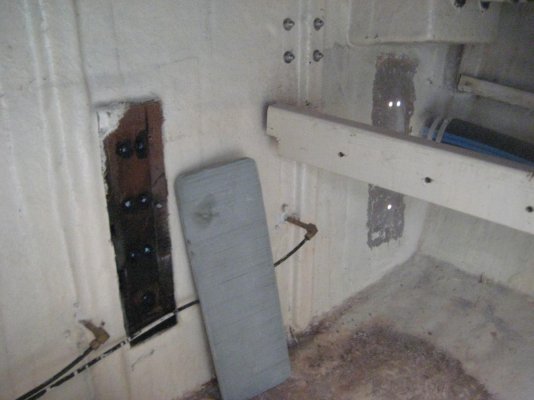DHeckrotte
Guru
I've emptied the lazarette of all junk in preparation for replacing the swim platform brackets' back-up blocks. In fact, I have cut out the original glassed-in wood and stainless steel back-up and will epoxy in new fiberglass back-up blocks. But, that's not what this post is for (but there is one pic, anyway).
I've found that the transverse plywood bulkhead separating the lazarette from the ER was apparently tabbed into the hull. There are no apparent limber holes through the bulkhead or through the small glassed-in transverse stiffeners on the hull. (Actually, I just discovered while taking pics for this post, that the center portion is open, leaving puddles outboard.) This means that there is no way for leakage water to make its way to the middle of the boat where the bilge pump is in its sump. There has been continuous leakage around the swim platform brackets' glassed-in bolts, minor leaks around the trim tab pistons, leaks from cracked scuppers, and overflow from blocked lazarette hatch gutter drains.
The transverse plywood bulkhead has delaminated and was badly, inexpertly repaired. It's due for a proper job, but not this spring.
I feel as though I should drill limber holes so that permanent puddles do not remain in the lazarette. Even though, of course, my new backup blocks and properly bedded brackets, as well as larger gutter drains should cut that down.
Thoughts? Why would there have been no limber holes in the lazarette? There are limber holes in the stiffeners and through the stringers in the ER.
I've found that the transverse plywood bulkhead separating the lazarette from the ER was apparently tabbed into the hull. There are no apparent limber holes through the bulkhead or through the small glassed-in transverse stiffeners on the hull. (Actually, I just discovered while taking pics for this post, that the center portion is open, leaving puddles outboard.) This means that there is no way for leakage water to make its way to the middle of the boat where the bilge pump is in its sump. There has been continuous leakage around the swim platform brackets' glassed-in bolts, minor leaks around the trim tab pistons, leaks from cracked scuppers, and overflow from blocked lazarette hatch gutter drains.
The transverse plywood bulkhead has delaminated and was badly, inexpertly repaired. It's due for a proper job, but not this spring.
I feel as though I should drill limber holes so that permanent puddles do not remain in the lazarette. Even though, of course, my new backup blocks and properly bedded brackets, as well as larger gutter drains should cut that down.
Thoughts? Why would there have been no limber holes in the lazarette? There are limber holes in the stiffeners and through the stringers in the ER.




